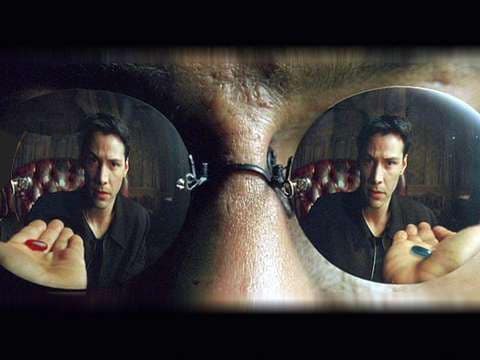| Online: | |
| Visits: | |
| Stories: |
The Terror of Inner Peace or How The Ego Keeps Us Miserable
By Adam J. Pearson

Introduction
My delightful Australian friend Si recently asked me an excellent question, which, like all excellent questions, has the power to open the doors to a whole new way of seeing. He asked: Can we be afraid of inner peace? Or, in other words, can we be afraid of attaining the very peace for which we yearn?
Perhaps surprisingly, my answer to this provocative question is “yes.” To most people, this is a perplexing answer; how could we possibly be afraid of peace of all things? In this article, I’ll reveal the strange psychological workings that make it possible to become terrified of the prospect of inner peace. I’ll also explain how this paradoxical situation arises as a result of the strategies that the ego uses to preserve our vulnerable sense of being a separate self. To quote Cypher in The Matrix, “buckle your seatbelt, Dorothy. ‘Cause Kansas is going bye-bye.”

The Ego’s Idea of Separate Identity
If you’re worried that I’m going to launch into a psychological ramble so abstract that only Sigmund Freud could understand it, don’t worry. We can get a concrete sense of the answer to Si’s question simply by considering our everyday experience.
Most of us believe that we are separate beings cut off from the rest of the world of other people, animals, and objects that surrounds us. We know what it feels like to be afraid of something we see as a threat to ourselves. We know what it means to feel the shame of believing that we, as separate beings, are fundamentally lacking or not good enough in some way. We know what it feels like to crave something that we hope will fill our inner void, satisfy us, or make us lastingly happy. We know the suffering and disappointment that comes from having our hopes dashed, our dreams crushed, from losing what we loved, or not getting what we wanted. We know the pain that flows from holding on to things and wishing they would last forever only to find that they change and let us down. We know what it feels like to constantly and often unintentionally judge others and fear being judged in the same way.
Yikes, what a way to start an article, you might be thinking. Talk about a bummer. Don’t get too down, dear reader; I’m heading in a positive direction. Indeed, I mention all of these experiences because they all stem from a common source. This source is the belief that we are a separate ego. Oh no, he’s bringing in the Freud! you may fear.

Not exactly. Here’s what I mean:
As I use the term, the ego is the part of the mind that believes it is a separate being that is cut off from the rest of the world.
[Note: for those who are familiar with it, Vedic philosophy uses the word ahamkara for what I mean by ‘ego.’ Don’t worry about this point if this sounds like gibberish to you.]
What does this have to do with the fear of inner peace? Read on to find out.

Protecting the Vulnerable Self: The Ego’s Strategies for Identity Defense
Because it believes it is a separate being, the ego feels a need to maintain a separate identity for itself. It wants to know who and what it is, to define itself, and to tell itself stories about its identity. In order to protect my separate identity, I need to have an idea of what I’m protecting. This story of who I am as a separate person is constantly changing. It is also vulnerable in the sense that it can be challenged by experienced, perceived threats, and competition from the apparently separate selves of others. As a result, the ego comes to see its sense of separate identity as needing to be defended. And it does this through a variety of specific strategies. Think of these strategies as being like swords that the ego wields to defend its little separate fortress from the invisible enemies it believes are constantly attacking it. Sound crazy? It gets crazier.

1. Strategy #1: Judging, Comparing, and Shaming
The first such strategy that the ego uses to defend its sense of separate identity is comparison and judgment. If I believe that I’m separate from other people, then I need to know how I stand relative to them. Am I better or worse? To find out, I compare my ego identity with those of other people I see as separate from me, I compete with them, and as a result, I judge some to be ‘better’ and some to be ‘worse’ than me. This isn’t a one time deal. If I see myself as separate from others and my identity as being at stake in comparisons with them, then I have to continually judge them and myself in order to see where I stand and preserve a positive image both for myself and as they see me. If this sounds exhausting, that’s because it is.
When the ego compares itself with the separate selves it believes other people have, it tends to experience a few different responses. These might remind you of some of your friends. For instance, the ego can see itself as coming out on top and being superior to others and thus feeling superior, arrogant, or proud. “Haha, I’m better than you!” it snorts, like a bratty child. It may also see itself as being on par with, or perhaps slightly ahead of most other people and thus feeling confident. “I’m not the best and I’m certainly not the worst. I’m alright,” it thinks. Or it may see itself as lacking in comparison with others and thus feel low self-esteem or shame. All of these feelings flow from the beliefs the ego adopts about its separate identity as a result of its judgments and comparisons.

2. Strategy #2: Blaming and Projecting
A second strategy the ego uses to protect itself is blame. By blaming others, the ego convinces itself that it is innocent. Think of a kid who steals a cookie from a cookie jar and blames it on his brother: “it wasn’t me, it was him!” That’s the kind of attitude we’re talking about here. Instead of taking responsibility for our own emotions, this strategy involves blaming others and framing ourselves as a victim. As you may know, the victim role is a very painful identity to identify with; when we take it on, we feel feel vulnerable, tremendously separate from a world that threatens us, and never safe.
If the ego cannot come to terms with aspects of itself that it judges to be negative, it tends to either repress, deny, or project these aspects onto others. If I project onto someone else what I cannot accept in myself, then I can judge and attack them instead of myself and thus avoid having to face what I do not want to face within me. Ever meet a really arrogant person who loudly proclaims that he hates arrogant people? That’s projection. Much of this tends to happen unconsciously until it gets brought into the light of consciousness.

3. Strategy #3: Fearing and Attacking
A third way the ego sustains its identity is by attacking anything that it sees as a threat to its separate self. this can mean physical attack, but usually means subtler forms of mental attack such as judging, criticizing, distancing oneself, hating, or getting angry. In the worst cases, the ego may also plan elaborate schemes to manipulate others to get what it wants or avoid what it doesn’t want or to undermine or sabotage potential competitors. Think of that girl back in high school who spread lies behind your back to spoil your chances with a guy or girl she wanted to date herself.

The need to attack is motivated by fear. This is because we fear what we see as threatening us. We cope with fear by attacking, either because we feel we have already been attacked and are counterattacking or because we feel that taking a preemptive strike will prevent us from being the victims of the other person’s first attack.
The ego feels a need to physically, mentally, or socially attack because it sees its identity as vulnerable and therefore requiring constant defense. If this reminds you of politics and the ever-present phenomenon of international war, it’s no coincidence; that’s the ego’s attack-and-defend mentality playing out on the global scale.
![]()
4. Strategy #4: Identifying and Distancing
A fourth strategy the ego uses to maintain its separate identity is constantly customizing its self-image. The ego thrives on constantly identifying with certain ideas, practices, and qualities and integrating these into its sense of self. “These things are totally me,” it thinks. This personality test will tell me what kind of animal I am, or what kind of Harry Potter character, or what fruit best represents me. “Ooh, banana!”

The ego also sees itself as having to constantly disidentify with or distance itself from qualities that it does not want to identify with. “At least I’m not like those people, who do all of these things that I would never do because i’m not horrible like them,” thinks the ego. Identifying with something always involves distancing oneself from its opposite, so identification and distancing go hand in hand. One involves the other.
Both identifying and distancing are parts of the ego’s constant self-narration. We find ourselves involved in a constant act of telling ourselves and others stories about who we are and who we are not. We believe these stories because they reinforce the sense of separate identity that we take to be ‘me.’ We’re like neurotic fiction writers who can’t stop writing our own fictional autobiography and believing that it’s true. If this sounds wild, that’s because it is.

4. Strategy #5: Craving and Managing Impressions
A final strategy that the ego tends to use to reinforce its sense of being a separate ‘me’ is craving. I don’t mean really wanting a hamburger here. I mean the deep yearning for things that we believe we need to feel happy, fulfilled, or obtain temporary relief from pain. Escapism and addiction both involve this idea taken to its logical extreme. In addiction and escapism, we come to believe that we need alcohol, or drugs, or sex, or pornography, or to overwork, or to overeat in order to be happy or fulfilled or escape the negative emotions that we don’t want to face. There are complicated issues with the brain’s dopamine system involved in addiction as well, but this is the kind of thinking that usually goes along with addiction in practice.

Of course, we realize that no impermanent form ever brings us the lasting happiness, fulfillment, or relief that we think it will. So once we obtain it, we drop it, and crave the next thing that we hope will do what every other thing failed to do in the past. “I’m so over my old iPhone,” we think. “I need the new model with all of its cool features!” The use of craving to reinforce our separate sense of identity is the driving mechanism behind consumerism. “Which phone case best defines me? Which sofa suits my personality?,” we wonder.
Our emphasis on fulfilling our desires is particularly heightened when we identify with core beliefs that make shame our dominant state. In this case, we crave a way out of desperation; we hope that we can fill our inner void by fulfilling our desires, but are continually disappointed to find that this strategy never succeeds in giving us what it promises. It simply doesn’t work because it doesn’t address the core issues involved in shame, only its surface symptoms.

Along with craving, when we identify with a separate sense of self, we feel a need to engage in what social psychologists call ‘impression management.’ If I see myself as separate, then I need to manage the impressions that other people have of me me so they see me as I want them to see me and don’t see me as I don’t want them to see me. The ego’s rationale is that I need to influence the way people perceive me because getting what I want in life and avoiding what I don’t want are tied to how other people see me and how I see myself.
Thus, craving and impression management are logically connected. I need to carefully manage impressions to ensure that I get the job I want, that people want to hang out with me, and that the people I’m attracted to respond well to me. I need to diligently manage my Twitter, Tumblr, Instagram, and Facebook pages so that people get all the right impressions of me and none of the wrong ones.

Does this ring any bells? If so it’s because impression management is universal. Social psychologists tell us that we all do this. It’s a tough practice to not get carried away with. Admittedly, it is also to some degree a necessary practice for living in a social world. However, even as we acknowledge that we do this, we need to also see that it’s a strategy for reinforcing my sense of a separate ‘me.’ For what else are the impressions that we want to manage of but a separate identity, body, and personality?

Why We Fear Inner Peace
This brings us to the surprising point about inner peace that follows from the use of all of these strategies to reinforce a separate ego. To maintain a sense of being a separate ‘me,’ I must feel that I have a lot of work to do, and that I must do it constantly. There is a whole lot of judging, comparing, blaming, shaming, fearing, attacking, identifying, distancing, and craving, and managing of impressions to do, and it must be done constantly, otherwise my vulnerable sense of separate selfhood may be in danger.

This is the exhausting conclusion we come to when we buy into the idea that we’re an ego. If this is what we believe and this is how we live, then it’s no wonder we feel so drained and exhausted a lot of the time.
Here’s the kicker: it is precisely for the reason that we need to keep engaging in all of this identity defense work that we can, consciously or unconsciously, fear attaining inner peace. If I sustain my ego by engaging in all of the strategies I’ve mentioned above, then being unconditionally at peace would mean that all of my constant work to maintain my separate identity is totally meaningless. If I believe I am the ego, then I live a life of constant judgment, fear, identity customization, and craving; I live in a world of constant disruptions to my happiness. I always have work to do to manage these disruptions and pursue what I want and ‘progress’ my separate sense of self. If I can be unconditionally at peace, then all of that work is meaningless.

Unconditional Peace: The Terror of the Ego
Here’s what I mean by that: from the perspective of unconditional inner peace, all of this identity work is unnecessary. What do I mean by unconditional inner peace?
Unconditional peace is a sense of peace as undisturbable, unthreatenable, and not dependent upon any conditions, nor even being a certain kind of person.
If peace is unconditional, then “I” do not need to maintain a sense of a separate self in order to feel peaceful because my peace cannot be attacked or threatened. I do not need to obtain anything or free myself from anything in order to abide in or realize in this peace. If this is true, then ego’s constant striving to judge, compare, blame, identify, distance, and crave in order to hopefully obtain peace sometime in the future is totally meaningless. It doesn’t make us any more peaceful. Indeed, if inner peace has no conditions, then what use is their to engage in all of these things to try to achieve it? All these strategies do is attempt to reinforce and defend the ego’s identity.

This is why peace can seem scary from the ego’s point of view. Because unconditional inner peace renders meaningless the fundamental activities that it uses to ‘preserve’ itself, inner peace thus the ego can see it as a threat to the whole way that it functions. The ego’s fear is that if I don’t constantly preserve my sense of separate self, it fears, then I could vanish, I could be attacked, I could even lose my sense of being a separate ‘me’ altogether!
The loss of the illusion of separation is the greatest terror of the ego, so this implication makes inner peace look absolutely terrifying. If I really accept inner peace on a deep level, then all of my identity strategies are meaningless. All of this ego identity work seems unnecessary. Could the ego see a bigger threat than what would render its constant work totally useless? What the ego sees as threatening, it fears. Do you see the logic here? The idea that unconditional peace could put the ego and its way of thinking and living out of business is terrifying to it.

The Kind of Peace the Ego Loves: Conditional Peace
And yet, we find ourselves constantly yearning for peace and trying to use all of these ego strategies to obtain it. Are we totally insane? The truth is that there is a logical reason for this. The ego does see the radical nature of unconditional peace as a threat to its separate identity; however, it is attracted to the idea of conditional peace.
Conditional peace is a sense of peace as a state of temporary relief from conflict and disruption that is conditional, can be threatened, can be disturbed, and depends upon being a certain kind of person.
Why is the ego attracted to the idea of conditional peace when it fears unconditional peace? Because if my inner peace has to be attained through hard work and protected against disruptions, then I still get to use all of my beloved identity strategies to pursue and defend it. I get to judge and compare your peace relative to mine, blame you for disrupting my peace, shame myself for not being able to maintain my peace, fear disruptions of my peace, attack threats to my peace, identify with ‘peaceful things’ and distance myself from unpeaceful things, and crave the next dose of temporary, conditional peace that will come my way. In short, I get to do everything the ego loves to do to protect its sense of self. Woohoo! exclaims the ego. I still get to do my thang!

Extending the Logic: Unconditional Love and Unconditional Joy
The reasoning that applies here to conditional and unconditional peace also applies to love and joy. The ego loves the idea that love and joy are conditional and temporary and that only these kinds of love and joy are possible. The ego’s view of love is that I am loved for my own separate identity and that what I love in you is your separate identity. Thus, my belief in separateness isn’t challenged by the idea of conditional love. Conditional love can be threatened, so I had better keep using all of my ego identity strategies to keep it alive or I’ll risk losing my identity and my love along with it. Yikes.
The ego is comfortable with the idea of conditional love because it fits nicely into the ego’s thought system; however, the ego is terrified of the notion of unconditional love, because it challenges its assumption of separateness. If I can feel a sense of generalized love that is unconditional, doesn’t depend on me and you being certain kinds of people, and cannot be threatened, then all of my ego strategies are meaningless. That prospect feels like a threat, so it terrifies the ego.

“Nuh uh,” says the ego. “There ain’t no such thing as unconditional love. That poppycock is for the hippies to chew on! Keep using all of my identity strategies. So what if they keep you miserable? Life sucks. I’m your best bet in this cynical world.” Except that you’re not.
The same reasoning holds for joy. The ego loves to see joy as something we can have more or less of relative to other people, that depends on my separate identity being a certain way, and that is conditional, temporary, and can be threatened. If joy is conditional and temporary, then I get to keep engaging in all of the ego strategies of judging, comparing, blaming, shaming, fearing, attacking, identifying, distancing, and craving to obtain, maintain, and avoid losing it. Being wholly and unconditional joyous renders all of these strategies meaningless and unnecessary. And that possibility, as we’ve seen, is terrifying to the ego.

Conclusion: Real Inner Peace is Possible
For all of the above reasons, to the extent to which we identify with the idea of being a separate ‘me’ or ego, and feel that the ego’s way of living is the only way open to us, we can be afraid of the idea of unconditional inner peace, joy, or love. However, here’s the truth that the ego doesn’t want us to know; we don’t have to identify with the ego. The more we begin to see from the perspective and direct experience of oneness rather than separation, the more unconditional peace, joy, and love can be revealed in our lives. Realistically speaking, it’s a learning process to get to that point, of course. In my own experience, I find that I still catch myself getting drawn into the ego’s seductive view of a separate identity and living in a world of separation. However, over the past few years, I have become more aware of oneness than I ever was before. The more we practice it, the better we get at it.
The key point is this: practicing seeing from the perspective of oneness and feeling joy, peace, and love as unconditional rather than conditional is something that we can do every day. The more we liberate ourselves from identifying with the ego, the more we begin to let go of its disruptive strategies for maintaining its own identity, practices which tend to distract us from the unconditional peace that lies within us. We don’t need these practices. There’s another way to live.

One part of this other way begins to reveal itself as the awareness of oneness begins to overlay our everyday view of the world. True, the conditioning that draws us into the ego’s perspective is strong at first because it has been built up over years upon years of self-reinforcement. Thus, it takes practice to remind ourselves that we can see things differently. Practicing mindfulness and forgiving what we perceive as disruptions to peace both within our own mind and “out there” in the world can greatly help us adapt to this new way of seeing.
In closing, wherever we now find ourselves, and regardless of the opposition and resistance we may encounter from the ego, we can take solace in the knowledge that inner peace is possible. As we reawaken to the Oneness that joins us all together and begin to slowly learn that what we fundamentally are cannot be threatened or endangered, we begin to see that the peace of the One does not depend on conditions because there are no separations within it. As we begin to free how we see, we will begin to realize that despite the ego’s constant strivings, we are already free. Indeed, we are the peace we seek.
Further Reading:
For a poetic reflection on the challenge of forgiving when we’re tempted to blame, see “The Light of the Mind.”
For a detailed discussion of shame and approval-seeking, see “Silencing the Praise: Why Seeking Approval Fails to Fill Our Inner Void.”
For a more detailed explanation of the awareness of oneness, see “The Mystic View of the World: On the Superposition of Absolute and Relative Perspectives.”
For a detailed discussion of nondual seeing, see “A Guide to Nondual Seeing: How to Reveal Oneness by Seeing Through ‘Separation.’
For a nondual course that uses language drawn from Christian mysticism to free us from dependence on the ego’s view of things and open us up to the perspective of oneness, see “A Course in Miracles.”
For a technique to find the assumptions at the heart of feelings of shame, see “The Heart of the Void: Finding the Assumptions at the Core of Shame.”
For some of the beautiful mandala art used in this article, see the artist Spektyr’s website.
Read More from Adam Pearson at http://philosophadam.wordpress.com/
Source: http://philosophadam.wordpress.com/2014/12/28/the-terror-of-inner-peace-or-how-the-ego-keeps-us-miserable/





